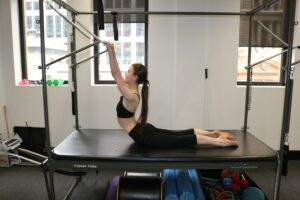Have you ever been informed you’ve got “floppy joints”?
The phrase HYPERMOBILITY is commonly utilized in a Physiotherapy session, however what does it actually imply if you’re hypermobile?
Most folks have some extent of mobility of their joints, however when this motion is elevated, and a joint strikes past the traditional vary, it’s termed hypermobility. Hypermobility is current in as much as 15% of the inhabitants in a single type or one other. In many actions, like dancing, yoga and gymnastics, a rise in joint mobility is taken into account advantageous, particularly as round 10% of the inhabitants who’re hypermobile is not going to have any signs. However, others can expertise signs, and that is when being “versatile” or “double-jointed” can develop into problematic. In these situations, hypermobility may cause a rise in joint ache, fatigue and an elevated danger of harm. Hypermobility can exist at only one or two joints, inside your peripherals or it might be widespread although out most joints. The situation generally runs in households and many individuals exhibiting hypermobility have relations who’re ‘versatile.’ Interestingly, joint hypermobility happens thrice extra ceaselessly in ladies than males.
When joint hypermobility is related to signs it may be categorized as HYPERMOBILITY SYNDROME (HMS). Hypermobility syndrome encompasses people who’ve hypermobility associated issues however would not have a Heritable Disorder of Connective tissue. Hypermobility may also be categorized based mostly on the presence of an underlying Heritable Disorder of Connective Tissue comparable to Ehler’s Danlos Syndrome and Marfan’s Syndrome, simply to call a pair. I’ll additional talk about how each syndromes current at a later level on this article.
Some of the commonest signs of hypermobility embody:
- Frequent subluxations or dislocations
- Chronic ache
- Neural tissue ache (eg. pins and needles)
- Gut points (eg. IBS)
- Autonomic dysfunction (eg. POTS)
- Anxiety
- Fatigue
- General deconditioning
- Excessive bruising
- Disrupted sleep
- Headaches / dizziness
- Pelvic flooring considerations or prolapse
Some different components that may contribute to hypermobile joints are:
- Strength/muscle tone- weaker, or extra relaxed muscle tissues enable for a better vary of motion.
- Bone form/Joint socket depth- shallow joint sockets, enable a better vary of motion than is taken into account regular.
- Poor proprioception (potential to sense motion)- chances are you’ll battle to sense how far you stretch your physique, resulting in hyperflexion.
What is the distinction between being versatile and hypermobility?
Flexibility refers back to the potential to elongate muscle tissues, hypermobility refers to a laxity within the ligaments surrounding the joints. In different phrases, you possibly can achieve flexibility via constant stretching methods, however you can’t stretch ligaments to extend joint mobility.
How have you learnt if you’re hypermobile?
There are two screening instruments which might be generally used to search for generalised hypermobility: The five-part questionnaire and the Beighton rating.
To reply the five-part questionnaire beneath it’s good to begin by pondering again to once you had been a youngster. Our joints are inclined to stiffen as we become older and subsequently, they don’t give a great illustration of the underlying mobility.
- Can you now (or might you ever) place your fingers flat on the ground with out bending your knees?
- Can you now (or might you ever) bend your thumb to the touch your forearm?
- As a baby did you amuse your mates by contorting your physique into unusual shapes or might you do the splits?
- As a baby or teenager did your shoulder or kneecap dislocate on a couple of event?
- Do you think about your self double-jointed?
If you answered ‘Yes’ to 2 or extra of the above questions, there’s a excessive chance that you’ve got joint hypermobility.
Your Physiotherapist will run you thru the Beighton’s rating which seems on the vary of movement of your fingers, thumb, elbows, again and knees via a collection of manoeuvres.
How can Physiotherapy assist?
Physiotherapy will be vastly useful for folks with hypermobility associated ache in each decreasing signs and prescribing an applicable train program designed to make sure that the joints are properly supported by the encompassing musculature. Physiotherapy mixed with Physio-led Pilates is commonly discovered to be the therapy of selection for these situations.
What will your Physiotherapist do for hypermobility?
- Complete a proper evaluation utilizing the Beighton’s Score which determines the presence or absence of hypermobility.
- Provide you with schooling relating to regular joint ranges and the right way to forestall an unstable joint by avoiding excessive joint ranges.
- Provision of energetic mobilisation workouts which may cut back pressure on injured ligaments, increase proprioceptive suggestions and optimise muscle motion.
- Provision of strengthening workouts which may stabilise muscle tissues round hypermobile joints which is efficient for joint assist and decreasing ache.
- Provision of proprioceptive workouts as a lower in joint place sense will make you extra susceptible to break. These might embody stability and co-ordination workouts.
- Control impartial joint place by figuring out the irregular resting place of symptomatic joints and retraining postural muscle tissues to facilitate optimum joint alignment.
- Retrain dynamic management involving retraining of particular muscle tissues to take care of joint place whereas shifting adjoining joints.
- Motion management which incorporates enhancing the power of particular muscle tissues to manage the joint via its whole vary, each concentrically and eccentrically, static and posture.
How can Pilates be useful for hypermobility?
Because of the elevated vary of movement within the joints, hypermobile particular person must have ample power for his or her complete vary of movement. Pilates works to extend stability, muscular power, and endurance – all of that are significantly necessary for hypermobility.
Another perform of Pilates is to extend proprioception, which is basically physique consciousness, involving particular consciousness, co-ordination, and stability. Hypermobile folks can have problem figuring out the place their physique is in house, just because they’ve a bigger vary of motion than others. Pilates focuses on constructing this consciousness and might have a major influence on enhancing our proprioception and enhancing inside stability.
Now getting again to each Ehlers Danlos syndrome and Marfan’s syndrome. Hypermobility is generally idiopathic in nature, however it may be a warning signal of a spread of underlying ailments. One of those ailments is a lesser-known situation known as Ehlers Danlos syndrome, a genetic situation which is inherited from start.
Ehlers Danlos syndrome can have an effect on the tendons, muscle tissues, ligaments, pores and skin, lungs, blood vessels, lenses of the attention and the guts valves in an affected particular person. The extent to which physique system is affected, is determined by the kind of Ehlers Danlos you’re affected by. There are 13 differing kinds which might be presently identified about and embody classical Ehlers Danlos which is characterised by bruising, scarring and hypermobility, vascular which is characterised by arterial ruptures and hypermobile Ehlers Danlos which is characterised by joint dislocations and pores and skin hyperextensibility. The method through which this situation and the subtypes are identified are based mostly on a set of outlined diagnostic standards and a genetic take a look at.
Ehlers Danlos syndrome impacts the collagen which makes up the joints and ligaments of our physique. There are a couple of various kinds of collagen that exist usually inside our physique with every collagen being represented by a sure gene or genetic marker. When the collagen is disrupted or not shaped appropriately it could have an effect on the areas of our physique that are fabricated from collagen such because the blood vessels, pores and skin and ligaments
The method through which Ehlers Danlos differs from pure hypermobility is often because of the related signs. It is assumed folks with Ehlers Danlos expertise signs of fatigue and joint ache along with the hypermobility and pores and skin extensibility that individuals with pure hypermobility have. People with Ehlers Danlos even have a spread of different systemic symptom’s that could be absent in somebody with hypermobility.
The therapy for Ehlers Danlos closely is determined by kind of Ehlers Danlos that you’ve got and the signs that you’ve got. For the kinds through which hypermobility and extensibility are the principle signs you will need to strengthen your joints and muscle tissues in an applicable method and restrict the stretching of your joints and muscle tissues. Supervised train packages with a physiotherapist is usually a great way of managing this. There can be a spread of medicines out there for ache aid and medical administration and monitoring is a necessity.
Marfan syndrome is a genetic dysfunction of the connective tissue affecting most notably the skeletal system, cardiovascular system, eyes, and pores and skin, amongst different physique techniques. Due to the widespread role of connective tissue all through the physique, people with Marfan syndrome could also be in danger for a lot of probably extreme or deadly co-morbidities due to the illness course of. Marfan syndrome is inherited via an autosomal dominant mutation of the gene encoding glycoprotein fibrillin-1 (FBN1), which performs a role within the anchoring of cells to the extra-cellular matrix and is the principle part of microfibrils. Microfibrils have an effect on the power and elasticity of connective tissue and management the discharge of progress components that trigger progress and restore of tissues and organs all through the physique. A defect on this gene implies that the standard and/or amount of fibrillin-1 within the physique is decreased, decreasing the quantity out there to type microfibrils, implicating modifications within the physique’s connective tissues and progress of tissues. Marfan’s most generally identified bodily traits embody a tall, skinny construct with lengthy fingers, arms, and legs.
People with Marfan syndrome can show all or any the next bodily traits:
- Tall, skinny physique construct
- Long legs and arms
- Elongated fingers and toes
- Unusually versatile joints
- Long slender face
- Highly arched roof of the mouth
- Crowded enamel
- Small decrease jaw
- Scoliosis (S formed curvature of the backbone)
- Pes planus (flat ft or fallen arches), Pectus excavatum (the place the breastbone sinks into the chest), Pectus carinatum (the place breastbone and ribs are pushed outward from chest)
- Arm span that exceeds physique peak.
Because sufferers with Marfan syndrome have completely different medical manifestations, physiotherapy could also be useful to the people who expertise issues from the musculoskeletal points which might be typically related to Marfan syndrome. This consists of however isn’t restricted to pes planus, scoliosis, and pectus excavatum and pectus carinatum and the bodily points they might trigger. Stretching, strengthening, therapeutic workouts, modalities for ache, fabricating or recommending orthotics, in addition to affected person schooling are all priceless instruments the bodily therapist can use within the administration of the affected person with Marfan syndrome. Physical therapists may play a role in advising the affected person with Marfan syndrome on the dangers and advantages of train and participation in sports activities. Specifically, the affected person must be educated on the danger to the cardiovascular system with strenuous and phone sports activities and must be suggested on the National Marfan Foundation’s Physical Activity Guidelines, ready by the NMF Professional Advisory Board.
If you’re involved that hypermobility is impacting you and want to see how Physiotherapy and Pilates will be useful for you, e-book in at Bend + Mend for an evaluation with one among our skilled Physiotherapists.


